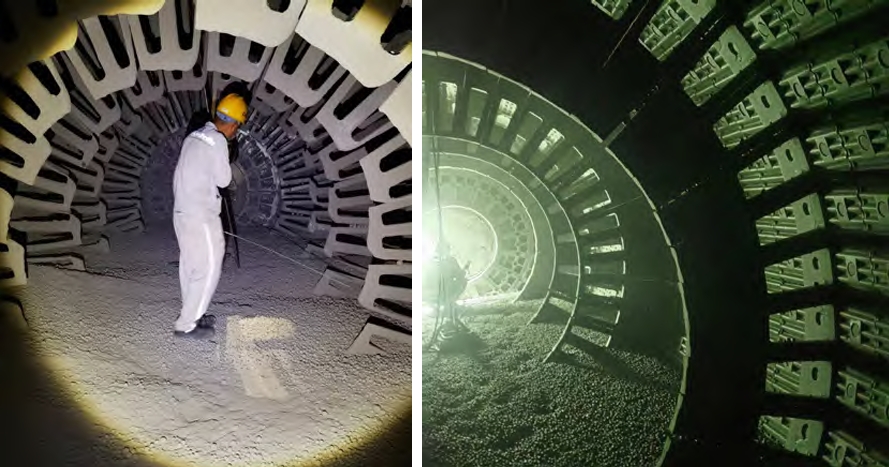Semi-autogenous grinding (SAG) mills are critical in mineral processing, where lining plates protect the mill shell and enhance ore breakage efficiency. These components endure severe impact, abrasion, and corrosion, leading to rapid wear. To extend service life and optimize performance, we conducted a comprehensive wear analysis using laser 3D scanning on trial lining plates from Wushan Copper Mine’s φ5.8 m×1.8 m SAG mill. This article details our methodology, findings, and structural improvements for different lining plate types.
Laser 3D Scanning Methodology
We selected six lining plate variants: wide lattice plate, long lattice plate, three feed-end plates (Liner-1, Liner-2, Liner-3), and a shell plate. Each plate underwent laser scanning using a KSCAN20 scanner (volumetric accuracy: 0.020 mm + 0.035 mm/m, resolution: 0.010 mm). Reflective markers were placed at 10 cm intervals on cleaned surfaces. Dual-side scans captured point cloud data, processed in Geomagic Design X to generate 3D reconstruction models and wear chromatograms. The reconstruction aligned worn profiles with original CAD models to quantify thickness loss. Wear rates ($W_r$) were calculated as:
$$W_r = \frac{T_o – T_w}{t}$$
where $T_o$ = original thickness (mm), $T_w$ = worn thickness (mm), and $t$ = service time (weeks).
Wear Analysis of Lining Plate Variants
Wear chromatograms revealed distinct patterns across lining plate types. Key findings are summarized below:
1. Lattice Plates
Wide and long lattice plates showed asymmetric wear concentrated at one end (wide plates at the narrow end, long plates at the wide end). Their intersecting arc regions exhibited 40% higher sieve wear than other areas. Bolt-hole thickness measurements highlighted severe degradation:
| Plate Type | Avg. Thickness (mm) | Min. Bolt-Hole Thickness (mm) | Max-Min Thickness Delta (mm) |
|---|---|---|---|
| Wide Lattice | 33.66 | 30.38 | 58.80 |
| Long Lattice | 36.42 | 32.17 | 52.34 |
Lifter bars were fully worn, reducing ore-lifting efficiency.

2. Feed-End Plates
Liner-2 experienced the most severe wear (avg. thickness: 46.00 mm), with fully degraded lifter bars. Liner-1 showed extreme wear unevenness—minimal wear at the narrow end but near-complete lifter loss at the wide end. Bolt-hole measurements:
| Plate Type | Avg. Thickness (mm) | Bolt-Hole Thickness Delta (mm) |
|---|---|---|
| Liner-1 | 60.64 | 71.15 |
| Liner-2 | 46.00 | N/A (uniform wear) |
| Liner-3 | 93.46 | 34.97 |
3. Shell Plate
The shell lining plate exhibited uniform wear (avg. thickness: 110.95 mm) with 20% higher degradation at the center. Crucially, transverse ribs added around bolt holes eliminated cracking observed in non-reinforced designs. Bolt-hole wear was highly consistent:
| Bolt-Hole Location | Avg. Thickness (mm) |
|---|---|
| Left | 109.79 |
| Right | 112.11 |
The stress-reduction effect of ribs is modeled by:
$$\sigma_r = \sigma_0 \cdot e^{-k \cdot N_r}$$
where $\sigma_r$ = stress with ribs (MPa), $\sigma_0$ = stress without ribs (MPa), $k$ = material constant, and $N_r$ = number of ribs.
Structural Optimization Strategies
Based on wear patterns, we redesigned each lining plate to homogenize wear rates and extend service life. Critical modifications included:
1. Lattice Plates
- Increased lifter bar height by 25%
- Added 15-mm reinforcement to high-wear sieves
- Integrated horizontal ribs at lifter bases
2. Feed-End Plates
- Liner-1: Replaced flat lifters with asymmetric design (low-left, high-right profile)
- Liner-2: Increased lifter height by 30%
- All variants: Added bolt-hole ribs
3. Shell Plate
- Retained triple-rib configuration
- Optimized rib curvature to redirect abrasive flow
Predicted service life extension is quantified below:
| Lining Plate Type | Original Life (weeks) | Optimized Life (weeks) | Extension (%) |
|---|---|---|---|
| Wide Lattice | 24 | 32 | 33.3 |
| Long Lattice | 26 | 34 | 30.8 |
| Liner-1 | 32 | 38 | 18.8 |
| Liner-2 | 22 | 30 | 36.4 |
Conclusions
Laser 3D scanning enabled precise wear mapping of SAG mill lining plates, revealing type-specific degradation mechanisms. Lattice plates suffered asymmetric end wear, while Liner-2 endured the most severe material loss. Transverse ribs on the shell lining plate prevented bolt-hole cracking. Our optimizations—lifter height increases, asymmetric profiles, and rib reinforcements—extended lining plate life by 19–36% and synchronized replacement intervals. Future work will validate these designs in full-scale operations and refine wear models using discrete element method (DEM) simulations.
